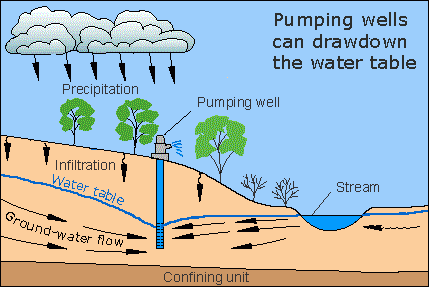Cone of Depression

a diagram illustrating the impact of pumping wells on the water table, titled "Pumping wells can drawdown the water table." It features a cross-sectional view of a landscape with trees, a stream on the right, and a cloudy sky with precipitation. The diagram shows precipitation falling from clouds, infiltrating into the ground, and contributing to the water table. A pumping well is depicted, extracting groundwater and causing a drawdown or lowering of the water table. Arrows indicate groundwater flow toward the well and a confining unit beneath the surface. The stream on the right is shown as part of the groundwater system.
- Surface Features
- Sky: Cloudy with precipitation
- Visual: Gray clouds with raindrops
- Land: Green trees and brown soil
- Stream: Blue water body on the right
- Sky: Cloudy with precipitation
- Water Processes
- Precipitation
- Position: Top, falling from clouds
- Visual: Black arrows pointing downward
- Infiltration
- Position: From surface into the ground
- Visual: Arrows moving downward through soil
- Water Table
- Position: Boundary between unsaturated and saturated zones
- Visual: Dashed line affected by pumping
- Precipitation
- Pumping Well
- Label: Pumping well
- Position: Center, extracting groundwater
- Description: Causes drawdown of the water table
- Visual: Well structure with arrows showing water extraction
- Groundwater Flow
- Position: Below the water table, toward the well
- Visual: Black arrows indicating flow direction
- Confining Unit
- Position: Bottom layer
- Description: Impermeable layer beneath the aquifer
- Visual: Brown layer at the base
Overuse of groundwater does not have to lead to major land subsidence before it causes problems. On a more local scale, over-pumping can result in lowering of the water table in a process called “cone of depression,” a generally concentric pattern of water table drawdown. Such over-pumping often results from industry or agriculture, but individual landowners often feel the repercussions.
Alternatively, a cone of depression can result when housing developments, particularly those with many small lots, use wells for water supply. A cone of depression can drastically decrease water pressure, or worse, lower the water table below the level of the well, leaving a home or a farm without a water supply. The only solution for this is to drill the well deeper, which can be an expensive proposition for an individual landowner. Left unchecked, a cone of depression can modify the flow of groundwater as well as the distribution of pollutants,
